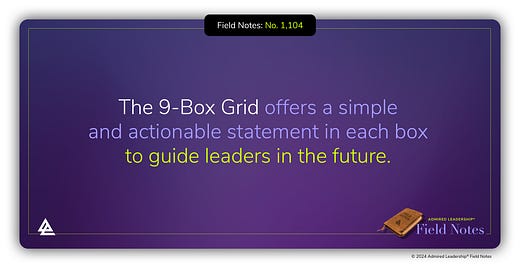Simple tools can be powerfully attractive, especially when it comes to complex decision-making regarding talent. Leaders need all the help they can get to put the right person in the right position at the right time.
The 9-Box Grid is just such a tool and is widely popular in many of the world’s best organizations. The reason is straightforward. It forces leaders to make judgments about talent that are instantly actionable.
The 9-Box Grid requires leaders and those evaluating talent to make a call about two essential assessments along an X and Y axis. Performance is rated from low to high on the bottom or X-axis in three boxes. Potential is also rated from low to high on the vertical side or Y-axis in three boxes.
By using performance metrics, year-end reviews, and ongoing feedback from discussions about talent, leaders can quickly come to conclusions about the boxes that most accurately reflect the two dimensions of performance and potential.
The 9-Box Grid offers a simple and actionable statement in each box to guide leaders in the future. If you’re unfamiliar with the grid, just Google the title and ask for images and you will see the statements in sharp relief.
To make the most of this tool, leaders need to set the standards for performance and potential before applying it. Since the definition of potential can vary from person to person and from role to role, deciding on the qualities that define it before using the grid is essential.
This tool should promote dialogue about talent and what it looks like inside the organization. Using the tool as a stand-alone, without letting it foster a robust discussion about the talent under assessment, diminishes its power.
The 9-Box Grid assists organizations in pinpointing future leaders, improving succession planning, identifying performance gaps and issues, igniting dialogue around talent placement, and suggesting development actions appropriate to where a person currently stands.
It is a simple and valuable tool which has made it widely favored in many organizations. Sometimes simple is the best answer. The 9-Box Grid is a good example of more from less.





You mention it here in the post...using the tool as a stand-alone, without letting it foster a robust discussion about the talent under assessment, diminishes its power. I had the privilege of working at a company where I worked in Talent Management. Then I transferred to an HR Generalist role and actually got to see how it was used first hand outside of the CEO suite. What I saw was largely an administrative exercise, an extension of the annual performance review. I convinced the leadership to let me run the sessions how they were originally intended and guess what? Leaders had robust discussions about their talent and most everyone found it to be a useful exercise. Unfortunately, what I see and hear from HR Colleagues is that Talent Assessment is pushed too far down into the organization and Corporate pushes these mandates down with little to know direction - mostly driven by whatever HRIS System is in place. What is missing is the robust talent discussions you mention in the post. If you're in a Corporate Talent Management role, get off your butt and out of your ivory tower and visit your local sites. Partner with your HR Site Leaders and Staff (don't just send a deck) and help them run the first first Talent Assessment meetings. Teach them how to get the most out of it.
9 Box is also being discarded for being too static. It lacks reliability and can exacerbate bias. It carries the risk of negatively impacting marginalized employees. Assigning a “name” or label to potential can shape a manager’s belief in their employee and that employee’s engagement. This encourages a fixed mindset. It is a blunt instrument to use with caution.